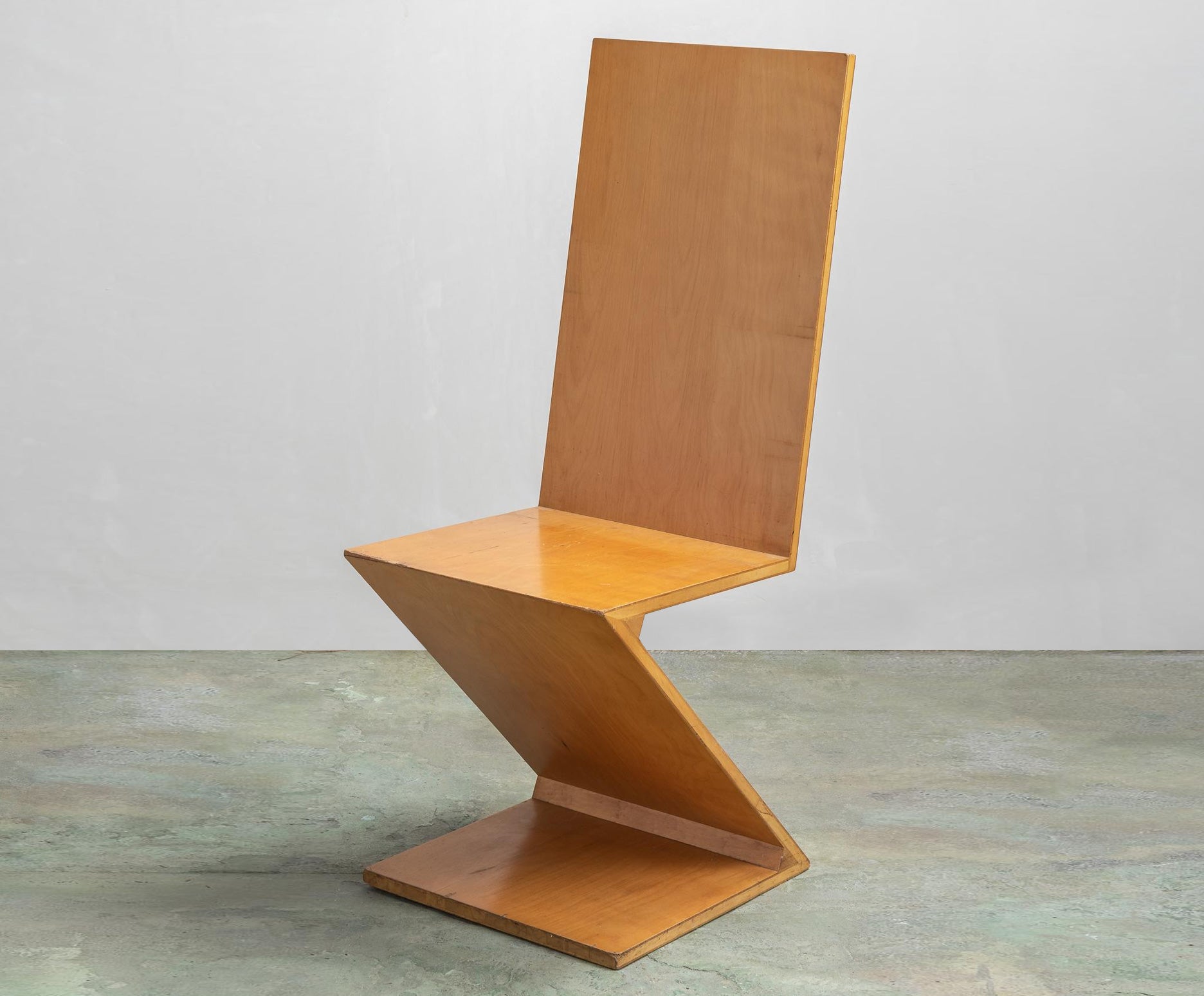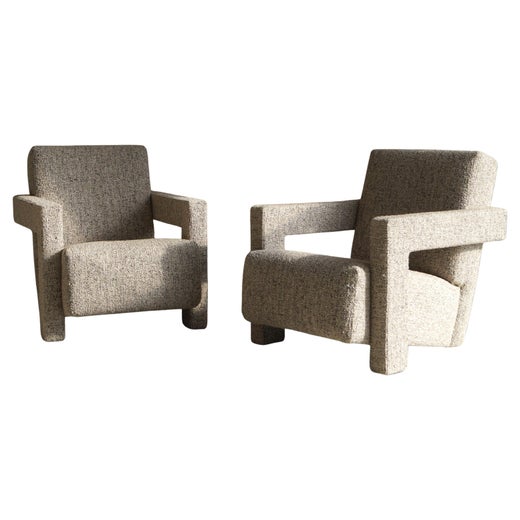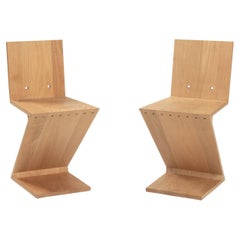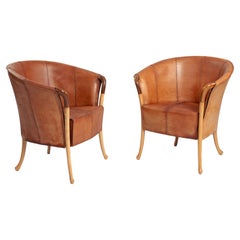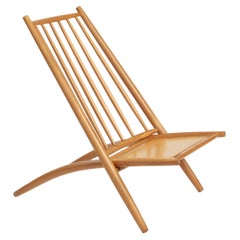Steltman chair after Gerrit Rietveld in oak, left and right version, set of 2
About the Item
- Creator:Gerrit Rietveld (Designer)
- Design:
- Dimensions:Height: 27.56 in (70 cm)Width: 19.69 in (50 cm)Depth: 17.72 in (45 cm)Seat Height: 15.75 in (40 cm)
- Sold As:Set of 2
- Style:Mid-Century Modern (Of the Period)
- Materials and Techniques:
- Place of Origin:
- Period:
- Date of Manufacture:circa 2000
- Condition:Wear consistent with age and use.
- Seller Location:Zevenaar, NL
- Reference Number:1stDibs: LU9519242124302
Zig-Zag Chair
“It is not a chair but a designer joke,” Gerrit Rietveld (1888–1964) famously said of the piece that would, ironically, become perhaps his most recognizable chair design. Introduced in 1934, the Zig-Zag chair was the result of Dutch department store Metz & Co having enlisted Rietveld to create a chair for mass production.
By this time, Rietveld had gained international acclaim for designs like his famous Red and Blue chair as well as the groundbreaking Rietveld Schröder House (1924) in his native Utrecht (now a UNESCO World Heritage Site), where he had brought to life many of the ideals of abstraction espoused in the De Stijl (“the Style”) movement. By the late 1920s, though, the designer had largely abandoned De Stijl in favor of a new movement, Nieuwe Zakelijkheid, or “New Pragmatism,” which aligned with other modernist movements for its emphasis on functionality and eschewing of ornamentation. Rietveld began experimenting with alternative, inexpensive materials like plywood and concrete. Metz & Co’s request for a simple seat, then, would seem a good fit.
In the form of the Zig-Zag chair, Rietveld delivered one of the earliest examples of a cantilevered seat. Unlike cantilevered models by Ludwig Mies van der Rohe and Marcel Breuer, however, Rietveld’s didn’t rely on a metal frame. In fact, the Zig-Zag chair is constructed completely from wood, its graphic shape a result of exceptionally precise craftsmanship. Rietveld hoped to produce a chair from one continuous piece of material; while the Zig-Zag doesn’t quite achieve that, it appears to: The seat’s four parts are connected by dovetail joints made from the same wood as the rest of the chair. As a result, the final product appears deceptively simple — despite the carefully calibrated measurement and engineering that goes into its shape, it has the semblance of precariousness.
Rietveld would go on to devise various versions of the seat — including a beloved high chair for children — and used it in many of the subsequent interiors he designed as his career developed into more of an architect’s than that of a furniture designer.
In 1971, Italian manufacturer Cassina bought the rights to the Zig-Zag chair and has been producing it ever since, even offering it in a selection of primary colored finishes, which harken back to Rietveld’s De Stijl days. The chair’s famous fans include artist Donald Judd and designer Karl Lagerfeld, and it sits in the permanent collection of the Museum of Modern Art.
Gerrit Rietveld
Best known for his Red and Blue chair, a modernist icon created using only two plywood plates and 15 connecting bars, Dutch designer Gerrit Thomas Rietveld trained as a cabinetmaker, and his bold vision for furniture was supported by his expertise in construction and craftsmanship.
Born in Utrecht, Rietveld learned goldsmithing in addition to the cabinetry apprenticeship he had in his carpenter father’s workshop. He studied draftsmanship with architect Piet Klaarhamer at the Utrecht Museum of Applied Arts and opened his own furniture workshop in 1917. In the 1930s, Rietveld began to experiment with then-unusual materials like plywood and aluminum, and he pursued intellectual concepts through his design, even considering a seat as a resting place for the body and the soul.
Designed in 1918, the minimalist Red and Blue chair is widely coveted by collectors and gained admirers in the likes of legendary American sculptor and designer Donald Judd over the years. (Examples of Rietveld’s designs can be found in Judd’s restored home-museum in New York City.) The Red and Blue chair is so stunning in its geometric simplicity that it is one of the most important symbols of the Dutch art and design movement of the early 20th century called De Stijl, of which Rietveld was an important part. De Stijl means “the Style” and was an effort to express utopian values through pure abstraction in design and the use of primary colors.
Another example of Rietveld’s celebrated seating furniture is the Zig-Zag chair, which was commissioned by the Dutch department store Metz & Co. and intended to be mass-produced. The resulting design — to which the rights to manufacture were bought by Cassina in 1971 — is the essence of the De Stijl movement and an example of Rietveld’s experiments with jointless chairs made from a single material, wood. The Zig-Zag chair’s armless, legless, elegant form is pure abstraction, yet it is also sturdy and comfortable.
Later in his career, Rietveld worked more often as an architect, designing buildings in prestigious settings like the Venice Biennale. He was a pioneer in more ways than one: The first building he designed, Rietveld Schröder House in Utrecht in 1924, is a radically modern space and has been a UNESCO World Heritage Site since 2000.
Find vintage Gerrit Rietveld furniture on 1stDibs.
You May Also Like
Vintage 1980s Dutch Bauhaus Side Chairs
Pine
Vintage 1980s Dutch Brutalist Side Chairs
Oak
Vintage 1970s Dutch De Stijl Side Chairs
Oak
Vintage 1960s Dutch De Stijl Chairs
Oak
Vintage 1980s Italian De Stijl Side Chairs
Cherry
Late 20th Century Italian Modern Side Chairs
Wood
2010s Italian Mid-Century Modern Armchairs
Leather, Wood
2010s Italian Mid-Century Modern Armchairs
Leather, Wood
2010s Italian Mid-Century Modern Armchairs
Leather, Wood
2010s Italian Mid-Century Modern Armchairs
Leather, Wood
More From This Seller
View AllVintage 1930s Dutch Modern Chairs
Elm
Vintage 1980s Italian Other Side Chairs
Leather, Beech
Vintage 1930s Dutch Art Deco Side Chairs
Straw, Oak
Vintage 1950s Swedish Mid-Century Modern Side Chairs
Beech
Vintage 1950s Italian Mid-Century Modern Side Chairs
Straw, Wood
Antique 17th Century British Medieval Side Chairs
Walnut
